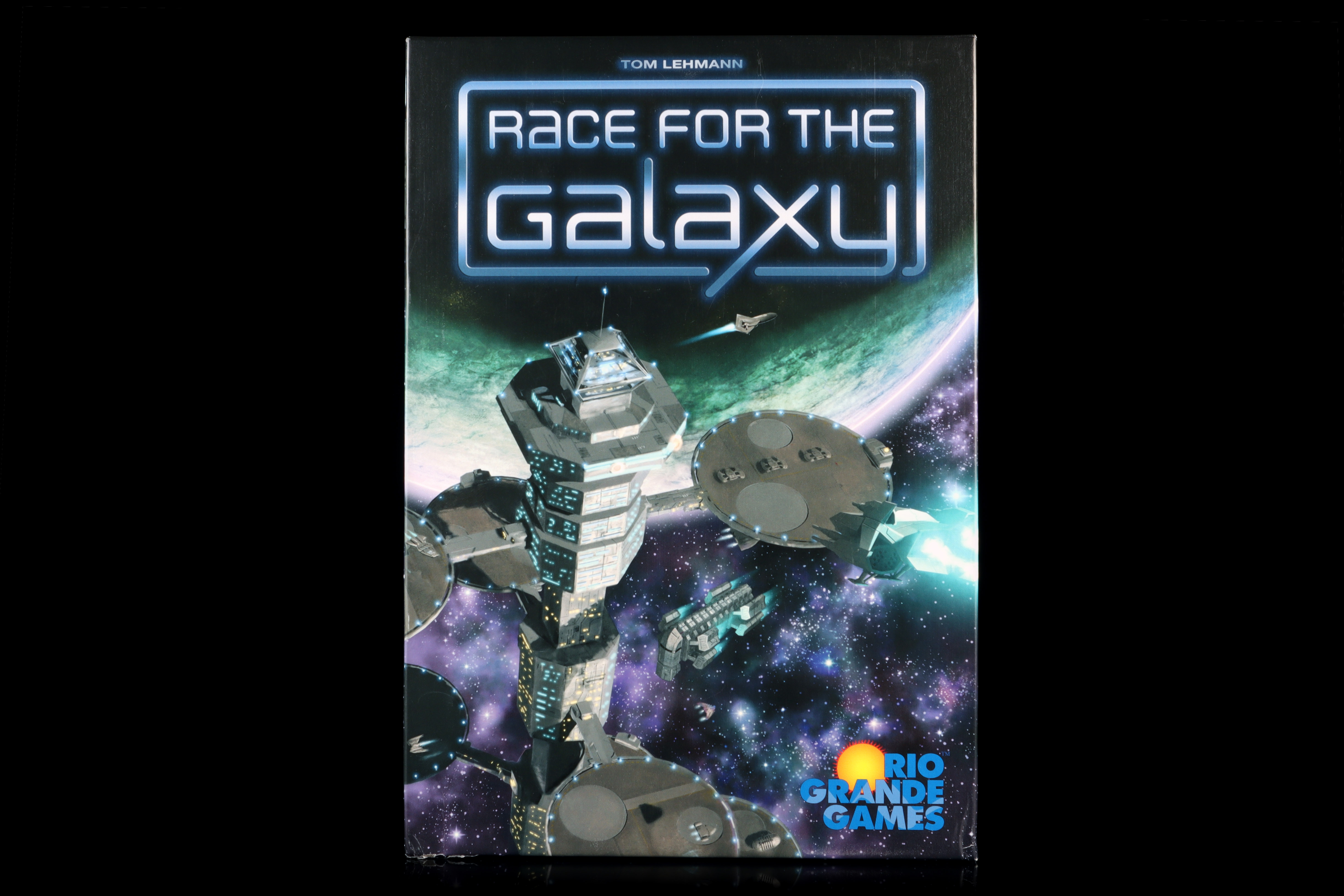Do you want to conquer the stars? Of course you do, who doesn’t? But how to conquer them, that is the question. Mass colonization? Military rule? Trade and economics? All paths are open in Race for the Galaxy, so let’s dig into the game and see why it’s great.
Race for the Galaxy is a competitive, 1 to 4 player, tableau-building, sci-fi card game. If a long string of board game buzzwords don’t do it for you, how about this: Race for the Galaxy is good. Really good. Like, really really good. Like, I have played over 3000 times it’s so good.

It’s the perfect game to play while waiting for an elevator, or while waiting on hold with the billing department. You already have your phone in your hand! Just launch Race for the Galaxy and play a game or two while you wait for your call to answered in the order it was received.
It’s worth mentioning right off the bat that not only is this a great traditional board game, but the app is also a fast, intuitive, fun to play implementation. The app even comes equipped with a ruthlessly smart AI built on a neural network and quite literally taught itself winning emergent strategies. We’ll come back strategies later, but just know that the screenshots you see are for the app version of the game, but they are functionally identical to the physical game.
Additionally, there are quite a few expansions to the game, but for the purposes of this article I will only be considering the base game plus The Gathering Storm (the first expansion) without using the “Goals” mechanic. If you don’t know what any of those mean, that’s fine. They’re not important to understand why this game is awesome. But just so you Race for the Galaxy veterans know, if I gloss over your favorite mechanic introduced in a later expansion, that’s why.
So What’s this Game’s Deal, Huh?
A fair question. The deal of this game is that you are racing against your opponents to be the first to conquer the galaxy. The metric by which galaxy conquerment is measured is the prestigious Victory Point, and whoever acquires more of these wins. There are two methods for acquiring these victory points. The first being the cards in your “tableau” and the second being victory points you earn by trading goods.

Victory via Colonization and Industrial Revolution
“Tableau” is a commonly used term among board gaming communities, but it basically means the cards you control that are played in front of you. In Magic the Gathering, your tableau is any permanents you control. In Through the Ages, your tableau is your workers, food, resources, military, science, leaders, and technologies. And in real life, your tableau is the friends you made along the way.
In Race for the Galaxy, your tableau is made up of a combination of two things: worlds and developments. Worlds are the planets you have colonized and are represented by cards with circles in the top left corner. World can create a wide variety of resources, trading opportunities, military advantages, or research bonuses. A clever player builds worlds that work together to create powerful combos. Have a world that produces a valuable Alien Technology? Well, the Galactic Engineers development will find a way of making that technology even more valuable.

Developments, on the other hand, largely act as modifiers and are represented by cards with diamonds in the top left corner. Developments frequently bolster and reward the worlds you have colonized and enable interesting and powerful combinations. Worlds and developments both earn you victory points (though some worlds have powerful enough mechanics that they hilariously award you negative victory points). Worlds always award a fixed amount of victory points, but developments are different. While most developments are worth a fixed amount of victory points, the interesting game-changing developments are different. Developments that have a cost of six (the number inside the diamond, we’ll touch on “cost” later), award victory points that scale off other cards in your tableau.
For example, let’s say you are going for a military victory. There are plenty of strengths to this, but the New Galactic Order development is the pièce de résistance. It turns each point of military power you have directly into a victory point. If you happen to get the New Sparta world, which gives +2 military power, and the New Galactic Order development in your starting hand, then you’ve got a strong path forward to victory. Not only do you start off with +2 military, but once you get the development into play those 2 military power turn into 2 victory points.


Victory via Capitalism
The second method for acquiring victory points is through pure supply and demand: the produce-consume cycle. You produce goods on worlds you control with one action, and consume those goods for sweet, sweet victory points with a separate action. While this strategy seems like a no-brainer, there are two important things to keep in mind.
First, after enough victory points have been earned through the produce-consume cycle, endgame is triggered (I use that awkward phrasing on purpose, and trust me, I’ll get to that). While this may or may not be some sort of statement on the finality of a resources in a capitalistic economy, it nonetheless limits how many victory points you can acquire from trading. Second, when you perform an action all other players get to also perform that action!
Now hold the phone, when you chose an action, everyone else gets to perform it? What is this, some sort of society where everyone works together and reaps the same benefits?
How Does This Space Socialism Work?
Each turn is separated into five phases in this order: Explore, Develop, Settle, Consume, and Produce. At the beginning of every turn, each of those phases are turned off. Each player then, in secret, selects a single phase that they would like to turn on. Everyone simultaneously reveals their choice of phase, and any phases left off are skipped that turn. However, a phase that is picked by any player is turned on for all players. This means your opponent could choose to Settle a world, and you could choose to Produce goods. So not only could you settle a world, but you could also produce goods on that world! And icing on the cake, each player who picked a particular phase gets a special bonus when that phase is active. I’ll go over the details of this in a bit.
First though, let’s go over endgame. At the end of each turn, two checks are performed and if either condition is met, the game ends:
- If any player has 12 or more cards in their tableau, then the game is over; or,
- If the total number of victory points awarded during all Consume phases exceeds the limit determined by the number of players, then the game is over. For example, in a two player game this limit is 24 victory points. So if a turn ends with 28 victory points awarded via Consume, then the game is over.
Another small note, there is an optional rule variant when playing with only two players: each player selects two phases to turn on instead of one. In my opinion, this is the best way of playing Race for the Galaxy. Not only do you get more tactical flexibility in your turn, but also the game plays quicker, lets you better judge your opponent’s intentions, and really seems like the way the game was mean to be played. If you are playing with two players, I 100% without hesitation recommend playing this variant. It’s a no-brainer. Just do it. Trust me.
Now that we have that out of the way, how does the game itself work? Once the turn starts, what do each of those five phases do, and what are these bonuses you get for selecting the phase yourself? Thanks for asking, I just so happen to have some words written about them, and those words are following this sentence and that picture.

Phase 1: Explore
Each player draws two cards, and discards one of them. Unlike most other phases, there are two different bonuses you can pick from when selecting this phase for yourself.
- Bonus Option 1: Draw one additional card, and keep one additional card.
- Bonus Option 2: Draw five additional cards.
Exploration is the quickest way to bump up your hand size. Because it’s the first phase of the round, if you are low on cards then you can explore to fill your hand by a card or two and have the resources you need to make your turn work.
Phase 2: Develop
You may take a development card in your hand, discard a number of cards equal to it’s cost (the number in the diamond) and add it to your tableau.
- Bonus: The development you select costs one fewer (to a minimum of zero).
Developments are the heart of the game. They turn the boring, static worlds in your tableau into powerful parts of a victory point engine.
Phase 3: Settle
You may take a world card in your hand, discard a number of cards equal to it’s cost (the number inside the big circle) and add it to your tableau. The exception to this is military worlds, which are indicated by the big circle being red. Military worlds may only be settled if your military power is at least equal to the world’s cost. If you meet that requirement though, you don’t have to discard any cards when settling it! Military might is eternal.
- Bonus: After settling a world, draw a card.
If developments are the heart, then worlds are the bones of the game. It’s almost impossible to win without at least a few worlds, and they provide all the infrastructure your victory point engine needs to see you to galactic domination.
Phase 4: Consume
Each world you have that can consume goods must consume goods exactly once. The only exception is if you do not have goods that can be consumed (for example, if you have a world that can only consume Genes (green) goods, and you only have only produce Alien Technology (yellow) goods, then you would do nothing this phase).
- Bonus Option 1: First, sell a single trade good for cards instead of victory points. The amount of cards you get ranges from 2 cards (for Novelty, blue goods) up to 5 cards (for Alien Technology, yellow goods).
- Bonus Option 2: During this phase, double the number of VP you acquire. Yes, this is as powerful as you think.
I suppose consuming goods is the stomach of the game? You can ignore production and consumption for a while, but your opponent is sure to pounce on all the opportunities you are missing out on.
Phase 5: Produce
Each “production world” you control produces a single good. A production world is indicated by the circle in the top left corner being filled in with either blue, brown, green, or yellow. The good it produces corresponds with the color of the world. Of note, no world may ever have more than a single good on it so don’t go thinking about loading tons of unsold goods on a single world. It won’t work.
- Bonus: A single “windfall world” you control also produces a single good. A windfall world is indicated by the circle in the top left having an outline of blue, brown, green, or yellow, but the center being white. These worlds automatically produce a good when you settle them, but otherwise don’t normally produce goods.
And the last phase is the sheer might of capitalism made manifest. Your worlds produce goods to either be sold off to the highest bidder, or for the honor of being thrown into a wood-chipper for victory points.
Funny enough, these five phases are really the entire games. Sure, I’m glossing over some rules, but just glancing through these phases gives you a broad understanding of what it’s like playing this game. But this isn’t Race for Second Place, or Race for Control of Subsector Omnicron Delta. No, this is Race for the Galaxy. The WHOLE galaxy. So you need to use these five phases and all your cleverness to win, but that begs the question:
How Do I Win at Space?
Here is where the beauty of the game lies. It has depth. It has strategy. This isn’t some shallow, “pick the card with the big numbers”, faux-tactics game. With every decision you make, you need to consider what opportunities you are passing up. You need to read your opponent’s tableau and figure out what their strategy is so you don’t feed into it, and preferably, so you can feed off it yourself. And what makes this game work so well is that none of these strategies are prescribed. There is no “Look at your opponents tableau” phase, and no “look ahead to see what phase they’ll pick next turn” ability. There are strategies that emerge based solely on how the rules and players interact. As an example, here are some strategies I’ve used for victory:
Quick Consume Gambit
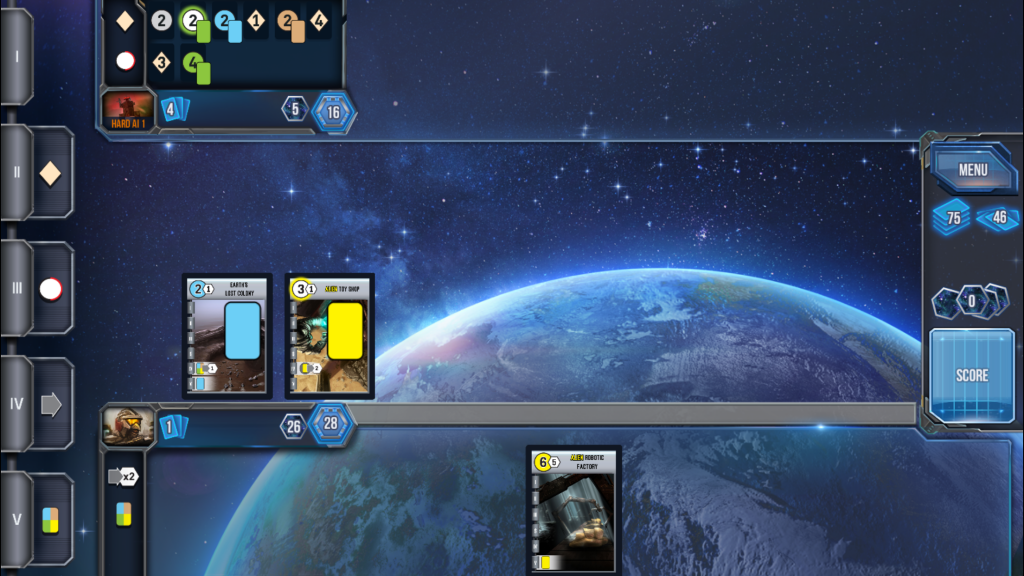
This strategy is based around there being a fixed number of victory points that can be acquired by consuming trade goods. The objective here is to rush this as soon as possible and end the game before your opponent’s engine can get up and running. This works when you have a couple production/consumption cards in your opening hand and you bet it all on them. I’ve found that if you can hit 6 victory points per turn by the second or third turn, then this can be a winning strategy. However, be on the lookup for this strategy you opponent might run …
Military Conquest
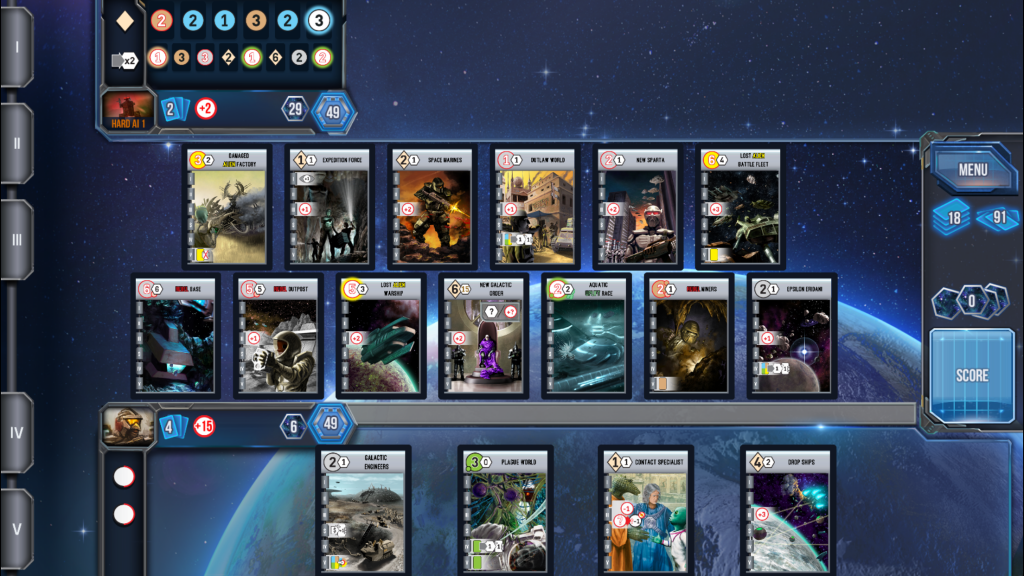
This strategy banks on the fact that you don’t need to discard cards to settle military worlds. You rush developments that give you military power, and this hard shift to settling military worlds. If you’re fortunate you might get some military worlds which are windfall worlds, and those automatically produce a single good when settled. If you get one of those, consume the good for additional cards in your hand, and hope for larger and larger worlds to conquer. I mentioned this earlier, but be on the lookout for New Galactic Order if you go with this strategy, as that development turns your military power directly into victory points. However, you need to watch for an opponent using this next strategy as you’ll be feeding the victory right to them …
Many Small Worlds
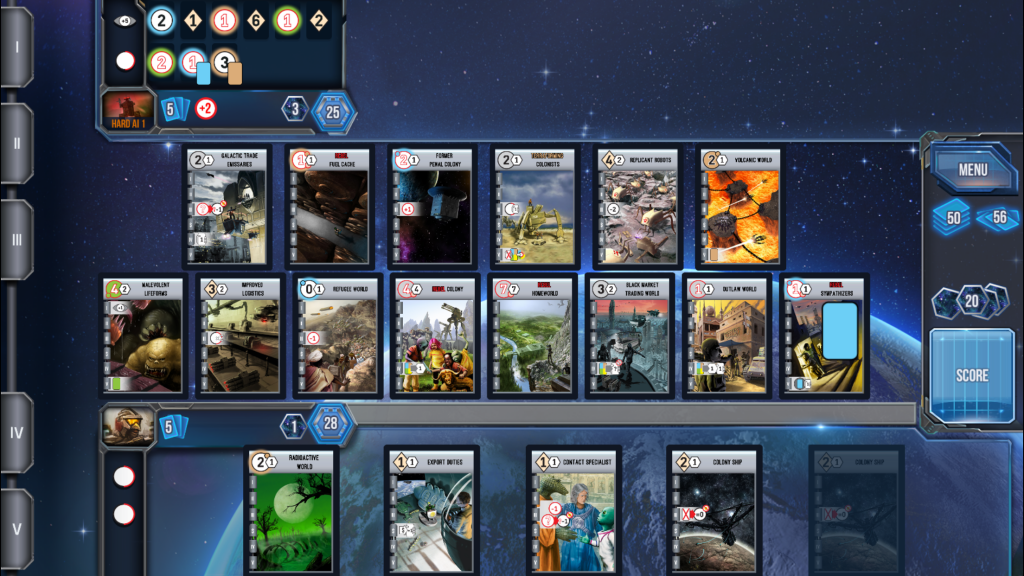
This strategy is similar to the Quick Consume Gambit, but instead of forcing endgame by burning through the consume victory points, you instead force endgame by settling 12 worlds (once any player has 12 cards in their tableau, the game ends at after the current turn finishes). If you are settling small worlds as fast as you can, then you can likely leech off any strategy an opponent plays into. Are they producing goods? Well, you have worlds that can produce goods, so hurray! Are they exploring to find that perfect card? Perfect, you also get more cards you can discard to settle your small worlds. However, be on the lookout for an opponent preparing the following strategy, as it can turn your sure victory into crushing defeat …
The One Drop
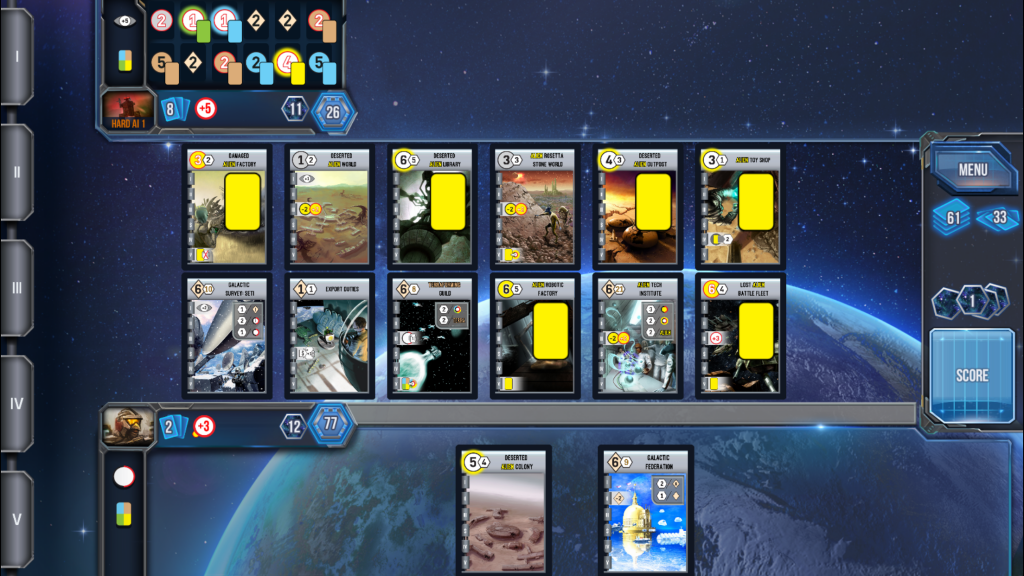
This strategy involves playing it coy. Build up a combo, but don’t trigger it. Let the embers grow hot, and when your opponent is about to end the game, light the fire with the one card you’ve been saving up to net you enough victory points to shoot ahead and win. This one usually comes down to pure luck, as it requires so many things to all line up, but in Race for the Galaxy, anything is possible.
Final Thoughts
While this game is fantastic, there are are some drawbacks that are worth mentioning. As you look at all of these cards, you’ll notice very little in terms of text. That’s because the game heavily relies on iconography to let you know what each card does. For someone who is thousands of plays in, and deeply internalized all those icons, this is actually a huge benefit as it only speeds the game up. However, for new players you will find yourself constantly referencing either the in-game help, or the handy reference sheet the game helpfully comes with.
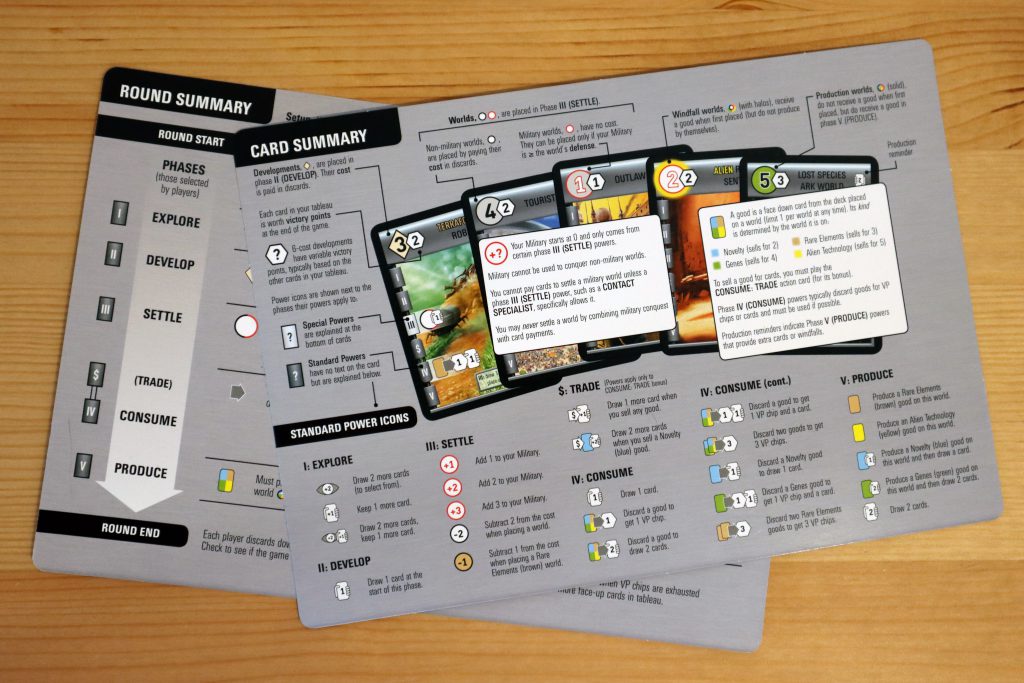
Other drawbacks are, I don’t know, it’s too much fun? The AI is too clever and forces you to really study every hand for the optimal move? The app is too inexpensive and well made? It’s too much of a perfect thinking game where skill and planning play a massive role in galactic rule?
It’s a great game once you learn the iconography, but that can be a problem if you are introducing the game to new players. You’ll likely need to explain each card in their starting hand for, because the iconography can be confusing if you aren’t familiar with it.
So overall: buy it, play it, enjoy it. The app costs as much as like two cups of coffee. It’s cheap, it’s good, and you might find the game you want to play thousands of times over. I know I did.
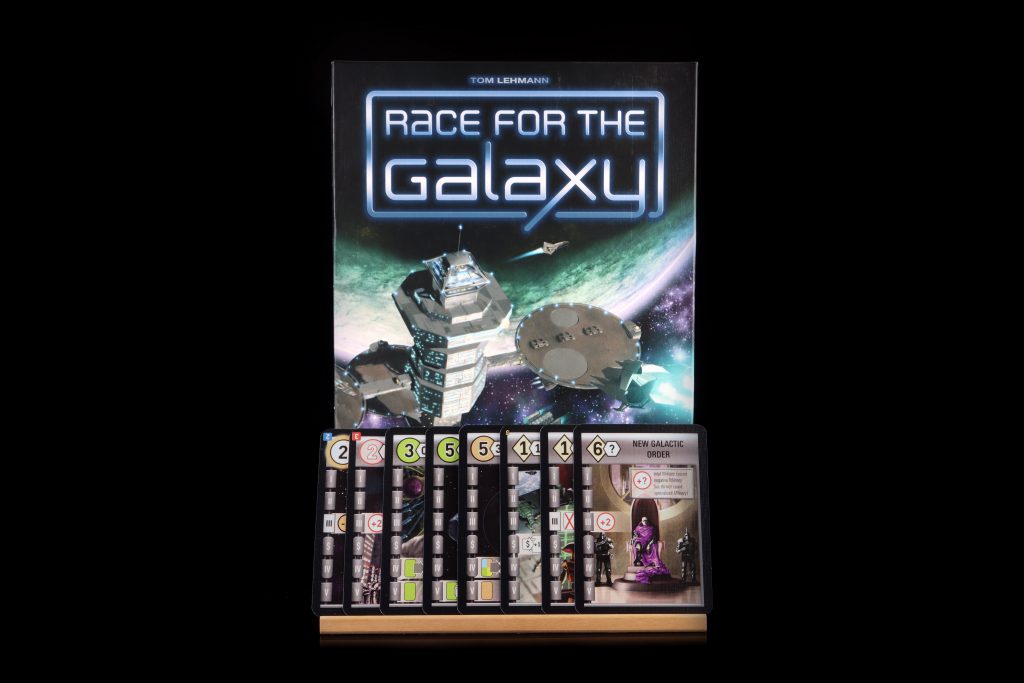
Final-er Thoughts: What If I Like Dice, Not Cards?
Race for the Galaxy received a re-imagining in the form of a cardless, dice-based game called Roll for the Galaxy. Roll is a slightly more casual version of Race, as the outcome of your random dice rolls can heavily swing what you are able to do during your turn. But it’s also a fantastic game in it’s own right. In fact, when I’m playing a for the Galaxy game with friends in-person, I frequently reach for Roll instead of Race. Throwing handfuls of dice with friends is just plain fun. But honestly, you cannot go wrong with either version, both are fantastic.
Wrap-up
And that wraps up Boardhammer: Race for the Galaxy. Have a comment on this hot take? How about your own opinion on this game, or do you have an idea for the next board game we should cover? Please drop us a note in the Comments below, or email us at contact@goonhammer.com.
